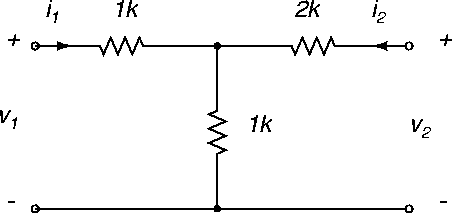 |
Let's find the impedance and hybrid parameter equivalent circuits of the circuit shown in Figure 58.
Impedance. Inspection of (67) indicates that we can find z11 and z21 by open-circuiting the right port (i2=0), and injecting a current i1 in the left port and determining the two voltages, Figure 59.
In this experiment there will be no voltage drop across
the 2 k![]() resistor, and the current i1 flows
through both 1 k
resistor, and the current i1 flows
through both 1 k![]() resistors. Equation (67)
says that
resistors. Equation (67)
says that


To find z12 and z22 we need a second experiment, Figure 60.
Equation (67)
says that


Hybrid. Inspection of (68) indicates that we can find h11 and h21 by short circuiting the right port, injecting a current i1 in the left port and determining v1 and i2, Figure 61.
Equation (68)
says that

Exercise. Show that
h12 = 1/3,
![]()
![]() and draw the hybrid
parameter equivalent circuit.
Hint. Open circuit the left port and
apply a voltage v2 to the right port.
and draw the hybrid
parameter equivalent circuit.
Hint. Open circuit the left port and
apply a voltage v2 to the right port.
ANU Engineering - ENGN2211